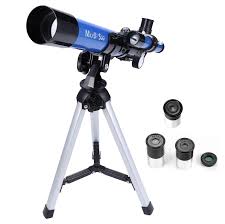Exploring the Universe: The Magic of Telescopes

The Wonders of Telescopes
Telescopes have long been a tool for exploring the vastness of space and unlocking the mysteries of the universe. From the earliest models used by astronomers like Galileo to modern observatories that peer deep into distant galaxies, telescopes have played a crucial role in expanding our understanding of the cosmos.
One of the key features of telescopes is their ability to gather and focus light from celestial objects, allowing us to see things that are too faint or distant to be visible with the naked eye. This has enabled astronomers to discover planets beyond our solar system, study the composition of stars, and even observe black holes in distant galaxies.
Telescopes come in various types, including optical telescopes that use lenses or mirrors to magnify images, radio telescopes that detect radio waves emitted by celestial objects, and space telescopes that orbit Earth to avoid atmospheric interference. Each type has its own strengths and capabilities, contributing to our ever-expanding knowledge of the universe.
Whether used for scientific research, amateur stargazing, or educational purposes, telescopes continue to inspire awe and curiosity about the cosmos. As technology advances and new discoveries are made, telescopes will remain essential tools for exploring the wonders of space and unlocking the secrets of the universe.
Exploring the Cosmos: Your Guide to Choosing the Right Telescope – Costs, Value, and Best Models for Viewing Planets
- How expensive is a decent telescope?
- Is buying a telescope worth it?
- What telescope is best for viewing planets?
- What is a telescope used for?
- Which telescope is best for seeing planets?
- Is a cheap telescope worth it?
How expensive is a decent telescope?
The cost of a decent telescope can vary depending on factors such as the type, brand, and features. Entry-level telescopes suitable for beginners can range from around $100 to $300, offering decent quality for observing the moon, planets, and some deep-sky objects. Mid-range telescopes with better optics and features typically cost between $300 to $1000, providing clearer views and more versatility in observing celestial objects. High-end telescopes designed for serious astronomers or astrophotographers can cost upwards of $1000 to several thousand dollars, offering superior optics, advanced tracking systems, and enhanced performance for detailed observations of distant galaxies and nebulae. Ultimately, the price of a decent telescope is a reflection of its quality and capabilities in exploring the wonders of the night sky.
Is buying a telescope worth it?
When considering whether buying a telescope is worth it, it’s important to weigh several factors. Firstly, determine your level of interest in astronomy and stargazing. If you have a genuine passion for exploring the night sky and are committed to learning about celestial objects, investing in a telescope can enhance your experience significantly. Additionally, consider your budget and the quality of the telescope you are considering purchasing. A well-made telescope can provide clear views and lasting enjoyment, but cheaper models may not meet your expectations. Lastly, think about how often you will use the telescope and whether you have access to suitable stargazing locations with minimal light pollution. Ultimately, buying a telescope can be a rewarding investment for those who are enthusiastic about astronomy and eager to delve into the wonders of the universe.
What telescope is best for viewing planets?
When it comes to viewing planets, many astronomers recommend a telescope with a larger aperture, such as a Dobsonian or Schmidt-Cassegrain telescope. These types of telescopes are known for their ability to gather more light and provide clearer views of planets like Jupiter, Saturn, Mars, and Venus. Additionally, telescopes with high-quality optics and good magnification capabilities are ideal for observing planetary details such as surface features, moons, and atmospheric phenomena. Ultimately, the best telescope for viewing planets depends on factors like budget, portability, and desired viewing experience.
What is a telescope used for?
A telescope is a specialized optical instrument designed for observing distant objects in space, such as stars, planets, galaxies, and other celestial bodies. Its primary function is to gather and focus light from these objects, allowing astronomers and stargazers to see them in greater detail than is possible with the naked eye. Telescopes are used for various purposes, including astronomical research, planetary exploration, astrophotography, and amateur stargazing. By magnifying and enhancing the visibility of celestial objects, telescopes help us better understand the universe and unravel its mysteries.
Which telescope is best for seeing planets?
When it comes to observing planets, the best telescope depends on various factors such as aperture size, optical quality, and portability. Generally, refractor telescopes with a larger aperture are preferred for planetary observation due to their ability to provide sharp and detailed views of planets like Jupiter, Saturn, Mars, and Venus. Reflecting telescopes with good optics can also be excellent choices for planetary viewing. Additionally, telescopes with high-quality eyepieces and stable mounts can enhance the viewing experience by providing clear and steady images of planets. Ultimately, selecting the best telescope for seeing planets involves considering individual preferences and specific observing needs to ensure an optimal planetary viewing experience.
Is a cheap telescope worth it?
When considering whether a cheap telescope is worth it, it’s important to weigh the pros and cons. While a budget-friendly telescope may offer an affordable entry point into stargazing and astronomy, it often comes with limitations in terms of optical quality, durability, and features. Cheap telescopes may have smaller apertures, lower-quality lenses or mirrors, and less precise mounts, which can impact the clarity and magnification of celestial objects observed. Additionally, cheaper telescopes may not be as durable or reliable as higher-end models, potentially leading to frustration and disappointment in the long run. Ultimately, investing in a higher-quality telescope may provide a more satisfying stargazing experience with better performance and longevity.